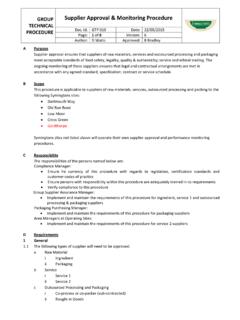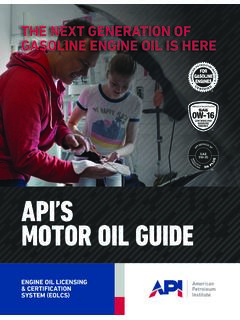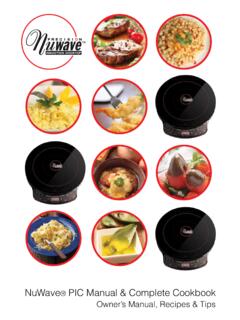Transcription of THE PALM OIL INDUSTRY IN MALAYSIA
1 THE PALM OIL INDUSTRY IN MALAYSIA From Seed to Frying Pan Prepared for WWF Switzerland by TEOH Cheng Hai, Hon. Advisor, Plantation Agriculture, WWF MALAYSIA , 49, Jalan SS 23/15. Taman SEA, 47400 Petaling Jaya, Selangor, MALAYSIA November 2002 The Palm Oil INDUSTRY in MALAYSIA : From Seed to Frying Pan THE PALM OIL INDUSTRY IN MALAYSIA : From Seed to Frying Pan Table of Contents Page Table of Contents ii Executive Summary v List of Tables viii List of Figures ix List of Plates x List of Abbreviations xi 1. Introduction Background Objective and Scope Approach 1 1 2 Part A: From Seed to Frying Pan 2. Introduction to the Palm Oil INDUSTRY Historical Background 4 The Oil Palm 4 Characteristics of Palm Oil 7 Food and Non-food Applications of Palm Oil 8 World Production of Palm Oil 10 Palm Oil Production in MALAYSIA 12 iiThe Palm Oil INDUSTRY in MALAYSIA : From Seed to Frying Pan 3.
2 Key Processes in the Production of Palm Oil Production of Fresh Fruit Bunches (FFB) 16 Production of Crude Palm Oil (CPO) and Palm Kernel 20 Production of Refined Edible Palm Oil 22 4. The Supply Chain of the Palm Oil INDUSTRY in MALAYSIA Introduction 24 Upstream Producers 26 Downstream Producers 33 Exporters/Importers 34 INDUSTRY Organisations 37 Government Agencies 40 Other Players 41 Customers 42 Linkages Among Major Players in the Palm Oil Supply Chain 43 Profiles and Performances of Major Plantation Companies 48 5. Conclusion 53 6. Acknowledgements 53 7. References 54 8. Appendix Appendix I Appendix II NACRA Criteria Environmental Reporting Award Published Environmental Policies of Plantation Companies 57 59 iiiThe Palm Oil INDUSTRY in MALAYSIA : From Seed to Frying Pan PART B: Profiles of Major Players in the Supply Chain of the Palm Oil INDUSTRY Plantation Companies Asiatic Development Berhad 63 Austral Enterprise Sdn.
3 Bhd. 65 Golden Hope Plantations Berhad. 67 Hap Seng Consolidated Berhad 69 IOI Corporation Berhad 71 Kuala Sidim Berhad 73 Kulim MALAYSIA Berhad 75 Kuala Lumpur Kepong Berhad 77 Kumpulan Guthrie Berhad 79 PPB Oil Palms Berhad 81 Tradewinds (M) Berhad 83 United Plantations Berhad 85 INDUSTRY Organisations Malaysian Palm Oil Association (MPOA) 88 The East MALAYSIA Planters Association (EMPA) 92 The Incorporated Society of Planters (ISP). 94 Palm Oil Refiners Association of MALAYSIA (PORAM) 97 The Malayan Oil Manufacturers Association (MEOMA) 100 Malaysian Oleochemicals Manufacturers Group (MOMG) 103 Malaysian Palm Oil Promotion Council (MPOPC) 106 Government Agencies Federal Land Development Authority (Felda) 110 Malaysian Palm Oil Board (MPOB) 114 Department of Environment (DOE) MALAYSIA 117 Natural Resources Environment Board (NREB) 120 Environment Conservation Department (ECD) 123 Other Players The National Association of Smallholders (NASH) 127 ivThe Palm Oil INDUSTRY in MALAYSIA : From Seed to Frying Pan Executive Summary Growing global demand for edible oils and animal proteins in the last decade or two had resulted in a tremendous increase in the areas under oil crops cultivation, particularly of soybean and oil palm.
4 In the last six years, the four main soybean growing countries comprising Brazil, Argentina, Bolivia and Paraguay recorded a 92% increase in production and 66% increase in planted area. World production of palm oil, the most widely traded edible oil, has also seen significant leaps in production and planted areas; production had almost doubled from 1990 to 2001, with MALAYSIA and Indonesia contributing to most of the increased production. The rapid expansion of both crops had resulted in the conversion of High Conservation Value Forests1 (HCVFs) in South America, including parts of the Amazon and in South-East Asia. As world production of palm oil and soyoil is expected to continue to increase at the current pace, there is a growing concern that this expansion would result in conversion of a large proportion of the remaining HCVFs in the tropics. In order to provide a better understanding of various issues pertaining to forest conversion and the edible oils sector, a study was undertaken on the supply chain of the palm oil INDUSTRY in MALAYSIA .
5 The study is divided into two sections, Part A gives an overview of the palm INDUSTRY and the players in the supply chain while Part B provides detailed information on the various players. The major players in the INDUSTRY can be grouped into clusters covering upstream producers, downstream producers, exporters and importers, customers, Government agencies and other players such as NGOs. Among these, upstream producers and customers, particularly institutional buyers and investors would be of more direct relevance to the issue of HCVFs. Of the million hectares of oil palm planted in MALAYSIA in 2000, 60% were under private ownership, particularly by plantation companies, were under Government land schemes while the remaining are individual smallholders. The largest upstream player is the Federal Land Development Authority (Felda) which was established in 1956 with the socio-economic mandate of developing agricultural land for the rural poor and landless.
6 Felda accounts for of the total planted area and of the palm oil produced in MALAYSIA in 2001. Plantation companies vary considerably in size, from a few hundred hectares to more than 100,000 hectares. The five largest companies in terms of planted area are Kumpulan Guthrie Berhad, Golden Hope Plantations Berhad, IOI Corporation Berhad and Sime Darby Berhad. Many present day plantation companies have their beginnings in the colonial era at the turn of the 20th century when English and other European entrepreneurs transformed forest land into tea and coffee and rubber estates. Amongst the old companies are Kumpulan Guthrie Berhad, Golden Hope Plantations Berhad, Sime Darby Berhad, Kuala Lumpur Kepong Berhad and United Plantations Berhad. Since the 1970s, several home grown companies have entered the INDUSTRY , the most notable example being IOI Corporation Berhad which started form zero base in 1983 to become one of the largest plantation companies today.
7 The equity of plantation companies in the country is largely under Malaysian ownership, the largest investors being the national equity corporation, Permodalan Nasional Berhad (PNB) and the Employees Provident Fund (EPF). PNB has 1 High Conservation Value Forests (HCVFs) are defined by the Forest Stewardship Council as forests of outstanding and critical importance due to their environmental, socio-economic, biodiversity or landscape values. vThe Palm Oil INDUSTRY in MALAYSIA : From Seed to Frying Pan substantial holdings in seven major plantation companies while EPF which provide retirement benefits for its members has made substantial investments in more than 14 plantation companies listed on the Kuala Lumpur Stock Exchange. Only a few companies have substantial or controlling foreign shareholding, notable examples being United Plantations Berhad and Pamol Plantatins Sdn Bhd which is Unilever s plantation interest in MALAYSIA .
8 However, the latter had recently announced to dispose all its plantations in the MALAYSIA . Besides production of crude palm oil, many companies are also involved in downstream production activities along the supply chain, such as palm oil refining, production of edible oil and palm-based products and manufacture of basic oleochemicals. The larger companies have also expanded their downstream operations offshore by establishing palm oil refineries in consuming countries such as India, Bangladesh, Pakistan, China and Egypt. Recently, two plantation companies established their presence in edible oils in Europe; Golden Hope Plantations Berhad acquired Unlilever s Unimills BV which is second largest processor of edible oils in Europe while IOI Corporation Berhad took control of Loders Croklaan BV, a global producer and supplier of specialty oils and fats.
9 Moving in the opposite direction, several companies have ventured into establishment of oil palm plantations off-shore, particularly in Indonesia to take advantage of the availability of land and workers and lower cost of production. The biggest player in this context is Kumpulan Guthrie Berhad which acquired about 200,000 hectares in Minamas Plantations in 2001. The diverse interests of upstream and downstream producers of palm oil and palm-based products and their derivatives are represented by a number of INDUSTRY organisations. The principal organisations are the Malaysian Palm Oil Association (MPOA), the Malaysian Palm Oil Board (MPOB) and the Malaysian Palm Oil Promotional Council (MPOPC). MPOA is the plantation owners association which has more than 100 members with more than million hectares planted under oil palm. This amounts to 70% of the area under private ownership.
10 MPOA s mission is to ensure the long term profitability and growth of the Malaysian palm oil INDUSTRY . MPOB is the public sector establishment responsible for undertaking research and development and for regulatory and licensing functions for the INDUSTRY . Its upstream and downstream research and development are built on a three-prong strategy to raise income through higher oil palm productivity, target for zero waste by maximising the utilisation of biomass and to increase the value chain of palm based products for various uses. The R & D activities of MPOB are supported by a research cess collected for every tonne of palm oil or palm kernel produced. MPOPC s primary role is to promote Malaysian palm oil; its activities are focused on marketing communications, technical marketing and market promotion locally and in several edible oil consuming countries. MPOPC s operations are supported by contributions from the INDUSTRY , based on volume of palm oil production, to the Palm Oil Promotion Fund.





